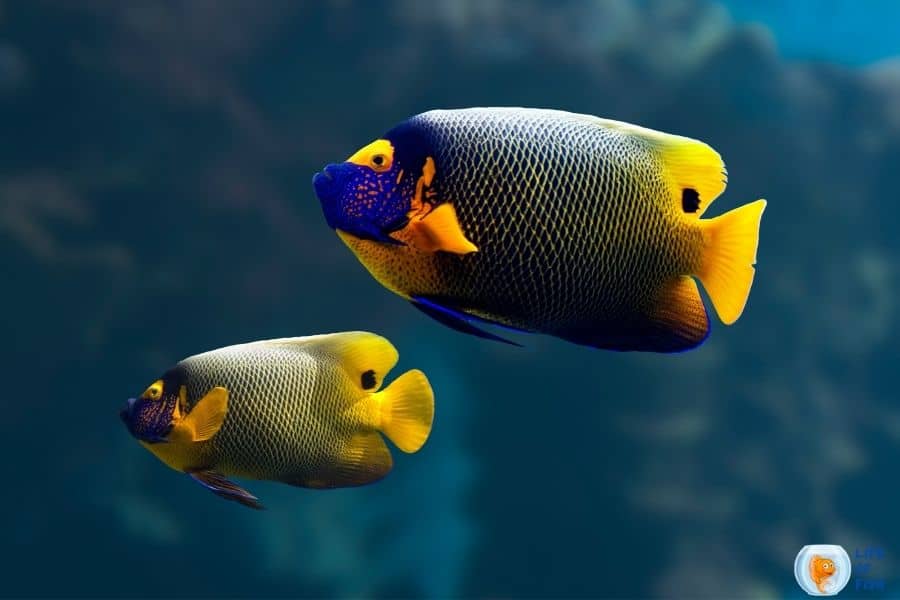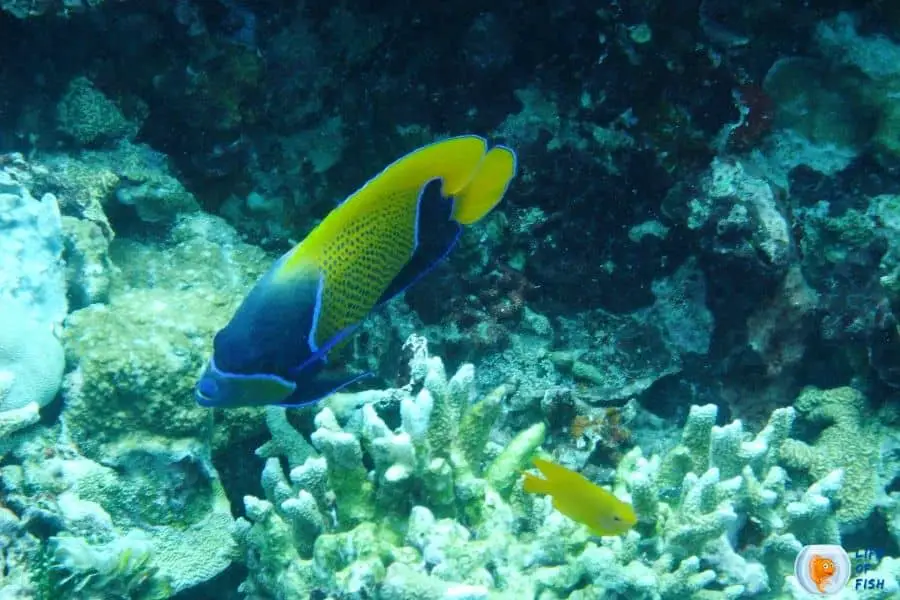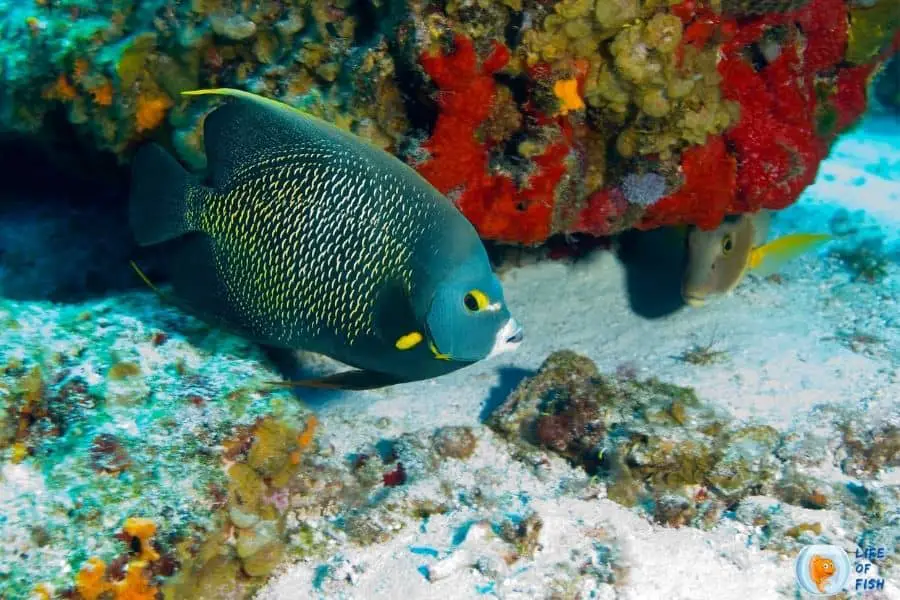What do saltwater angelfish eat? They are omnivorous and eat both plants and meats.
Saltwater angelfish are among the most beautiful aquarium fish because of their varied color patterns and their unique shape. They are the main reason why freshwater aquarists often start keeping saltwater fish.
However, before you add one of these beautiful fish to your aquarium, it is important to know what they eat and whether or not their diet is compatible with the other inhabitants of your tank. Let’s find out here.

Amazing saltwater angelfish!
Jump To
- 1 Amazing saltwater angelfish!
- 2 Are saltwater angelfish easy to care for?
- 3 What do saltwater angelfish eat?
- 4 How to acclimate saltwater angelfish to aquarium food?
- 5 Saltwater angelfish care
- 6 Saltwater angelfish Tankmates
- 7 What about different angelfish species?
- 8 Breeding saltwater angelfish
- 9 Conclusion
Belong to the Pomacanthidae family; there are about 86 species of saltwater angelfish. They live in tropical and subtropical reefs all over the world.
Saltwater angelfish are popular in the aquarium industry because of their brilliant colors and unique patterns.
Most saltwater angelfish feature a laterally compressed body with a small mouth and large pectoral fins.
Most species of saltwater angelfish grow to be about 6-8 inches (15-20 cm) long, but some can reach up to 24 inches (60 cm) in length. Some of these species are easy to care for in aquariums, while others are difficult.
While most saltwater angelfish are peaceful, some species can be aggressive towards tank mates. So, you need to do your research about specific species before adding them to a community tank.
They are diurnal species that stick to shallow reef environments in the wild. They eat a diet of small invertebrates, algae, and zooplankton in their natural habitats.
Are saltwater angelfish easy to care for?
This can be a hard-to-answer question because there are over 80 species of saltwater angelfish that have different care needs.
However, most saltwater angelfish are easy to care for IF you provide them with the right environment and diet. Some species reject aquarium food and starve to death even under perfect conditions.
Therefore, bringing any saltwater angelfish into your home aquarium should never be done on a whim.
You should research the specific species you are interested in and make sure that you are prepared to meet their needs.
What do saltwater angelfish eat?
Saltwater angelfish are omnivores that eat both plant matter and meat.
What they will eat in the wild versus in an aquarium changes a lot because it is hard to provide them with the same variety and quality of food that they would find in nature.
In the wild
Saltwater angelfish are natural grazers that spend most of their time picking at rocks and reefs for food.
They will also consume algae, small invertebrates, and zooplankton that they find in the water column.
Most of the saltwater angelfish species are carnivores that eat mostly meat. They prefer planktons, hydroids, tunicates, sponges, and bryozoans (Ex. sea squirts, jellyfish, and hydroids).
Some species, such as the Flame angelfish (Centropyge loricula), have a diet that consists mainly of coral invertebrates and anemones.
In captivity
The diet of a saltwater angelfish in captivity will be very different from what they eat in the wild. In an aquarium, they will not have access to the same variety or quality of food.
Aquarium keepers will need to supplement their diet with commercial foods, such as flakes, pellets, and live/frozen foods.
It is best to offer angelfish a varied diet consisting of plant matter and meat. A good diet for saltwater angelfish should include:
- Pellets or flakes
- Live/frozen foods (Ex. prawn, shrimps, brine shrimp, mysis shrimp, krill)
- Vegetables (Ex. blanched spinach, zucchini, and peas)
- Algae
Additionally, some shops sell frozen angelfish food, such as algae formula, formula 1, angelfish formula with sponges, and marine angelfish pellets and flakes.
We always recommend buying them instead of live or frozen foods if you have access to this food because they provide a more complete and balanced diet.
Certain species accept only specific food
As we mentioned before, certain species reject food in captivity. This is because they are solely live sponge feeders. These species only eat live sponges that they find on reefs in the wild.
Some examples of sponge-eating angelfish include Barred angelfish (Centropyge multifasciatus), Hawaiian bandit angelfish (Apolemicthys arcuatus), Oriole Angelfish (Centropyge bicolor), and Regal angelfish (Pygoplites diacanthus).
Because of the decreased adaptability of these species, they are considered to be difficult to care for.
If you are thinking of purchasing one of these species, we suggest that you conduct thorough research and be prepared to meet their specific needs.

How to acclimate saltwater angelfish to aquarium food?
Most saltwater angelfish sold at the shops are wild-caught ones, which means they are not used to aquarium foods. So, it is important to acclimate them to aquarium settings, which is somewhat hard to do.
When buying an angelfish, ensure that you buy a larger juvenile or sub-adult specimen as they are relatively easy to acclimate.
The best way to start the acclimation process is by feeding them live foods, such as brine shrimp or mysis shrimp. You can also offer them frozen foods that have been thawed and squeezed of excess water.
Once they start accepting these foods, you can slowly introduce pellets and flakes into their diet. It is best to do this gradually over the course of a few weeks.
Tip: If you already have an acclimated angelfish of the same species, you can try keeping them together to acclimate the new fish into the aquarium.
Like many other animals, fish tend to imitate other fish when they see other fish eating something.
So, even if they are not used to aquarium food, you can easily get them to start eating by keeping a well-fed fish with them.
However, be careful as angelfish may fight with each other to establish their territory. If you try this trick, you need to have a large enough aquarium for both fish and keep a close eye on your fish to ensure they are not fighting.
Saltwater angelfish care
Now that you know what saltwater angelfish eat, the next thing you need to do is provide them with the proper care. Here is some advice on caring for your saltwater angelfish.
Recommended saltwater angelfish species
As mentioned above, some angelfish species are easy to care for, while others are nearly impossible.
Therefore, experts suggest only easy-to-care-for species as aquarium pets. For those who are looking to keep saltwater angelfish, here are some of the best species to keep:
- Queen Angelfish (Holacanthus ciliaris)
- Pearlscale Angelfish (Centropyge vrolicki)
- Emperor Angelfish (Pomacanthus imperator)
- French Angelfish (Pomacanthus paru)
- Yellow Tail Angelfish (Apolemichthys xanthurus)
- Blueface Angelfish (Pomacanthus xanthometopon)
Tank setup
Although saltwater angelfish are hardy species, you can not just buy them and add them to your fish tank.
You have to plan about three months in advance if you want to keep them as pets successfully. This is because they need a very stable and well-established aquarium with the proper water parameters.
Angelfish require a reef tank set up to thrive. Also, you have to run the tank for at least three months to ensure that your tank’s Nitrogen cycle is fully established.
You will also have to perform water changes to make sure the water quality is up to par during that time.
Angelfish are active swimmers, and they also need a lot of hiding places. Therefore, you need to provide them with plenty of live rock in the aquarium. Live rocks provide them with hiding places and a place for them to graze.
For filtration, we recommend a protein skimmer as it does a great job in removing the waste products from the water. You can also use canister filters and power filters.
Since these are diurnal species, lighting is also an important aspect of their care. You will need to provide them with at least 10-12 hours of light per day.
We recommend using full-spectrum lighting as it closely resembles the natural sunlight.
Water parameters
The ideal water temperature for these fish is between 72-82 degrees Fahrenheit. The pH should be between 8.1 and 8.4, and the salinity should be between 1.020-1.025.
Water hardness is not a big concern for these fish as they can adapt to a wide range of water hardness. However, the ideal water hardness for them is between 8-12 dKH.
You also need to ensure that the water is well oxygenated. You can do this by using an air pump and air stone.
However, remember to keep a light water flow in the aquarium as these fish come from slow-moving water in the wild.
What size tank do saltwater angelfish need?
The minimum tank size for saltwater angelfish is 50 gallons. However, we recommend a 75-gallon tank or larger if you want to keep more than one fish.
Further, if you choose to keep a larger angelfish species like the Emperor Angelfish, you will need an even larger tank.
Larger angelfish can grow up to 18 inches in the wild, and they will need at least a 200-gallon tank.

Saltwater angelfish Tankmates
Since different saltwater angelfish species have different temperaments, you have to be careful when choosing tank mates.
Usually, small and medium-sized angelfish species are fairly peaceful, while large angelfish species are very aggressive.
Angelfish usually cohabit well with smaller peaceful fish. However, they must be large enough not to become prey for the Angelfish.
Some of the best tank mates for smaller saltwater angelfish include:
- Clownfish
- Gobies
- Cardinalfish
- Dottybacks
- Tang
- Wrasse
- Butterflyfish
- Dartfish
- Blennies
On the other hand, large, aggressive fish are known to eat smaller angelfish. So, you should avoid large, aggressive fish in an angelfish tank. some of the fish that you should avoid keeping with smaller saltwater angelfish include:
- Basslets
- Damselfish
- Grouper
- Pufferfish
- Triggerfish
- Lionfish
- Eels
If you have a larger angelfish species like the Emperor angelfish, things become otherwise.
Since large angelfish are aggressive, the suitable tankmates are similar or large-sized fish and have similar temperaments. So the above “Avoid” list will become the “suitable” list in this case.
Additionally, you should avoid smaller, peaceful fish as large angelfish tend to bully and eat smaller fish. So the above “Suitable” list will become the “Avoid” list in this case.
What about different angelfish species?
You might think that saltwater angelfish will do fine when kept with other saltwater angelfish species. Unfortunately, that’s not the case.
Different saltwater angelfish species have different temperaments, and they usually don’t get along with each other. So, it’s best to avoid keeping different angelfish species together in the same tank.
The only exception rule is if you have a very large tank and the angelfish species are similar in size. Even in this case, there is a chance that they might not get along and you should be prepared to separate them if necessary.
Still, if you plan to keep several angelfish species together, you must introduce the smallest fish first and then gradually add the larger fish. This will help reduce the likelihood of aggression and fighting.
Breeding saltwater angelfish
Saltwater angelfish are relatively difficult to breed in captivity. However, given the proper setup and conditions, it is possible.
Still, the survival rate of saltwater angelfish fry is quite low, and most of them will not make it to adulthood.
To breed saltwater angelfish, you will need a separate breeding tank that is at least 150 gallons in size. The water parameters in the breeding tank should be similar to the parameters in the main tank.
You will also need to add some live rock or coral to the breeding tank, as this will provide the fry with places to hide and food to eat.
When the time is right, the female angelfish will lay a batch of eggs on the live rock or coral. Once the eggs are laid, the male angelfish will fertilize them.
After a few days, the eggs will hatch, and the fry will start to swim around. At this point, you can begin feeding them live food such as baby brine shrimp or micro worms.
You can gradually start feeding them larger food items such as frozen food or pellets as they grow.
Conclusion
Saltwater angelfish are beautiful and popular fish commonly kept in saltwater aquariums. They are fairly easy to care for, but they do have some specific requirements that you need to be aware of.
When choosing a saltwater angelfish, choosing the right species for your tank is important. Some species of angelfish are more aggressive than others, and they might not do well in a community tank.
Choosing the right tank mates for your saltwater angelfish is also important. If you provide your saltwater angelfish with the right environment and care, they can live for many years in your aquarium.
Read Next : Northern Clingfish | A Weird Looking Fish |

